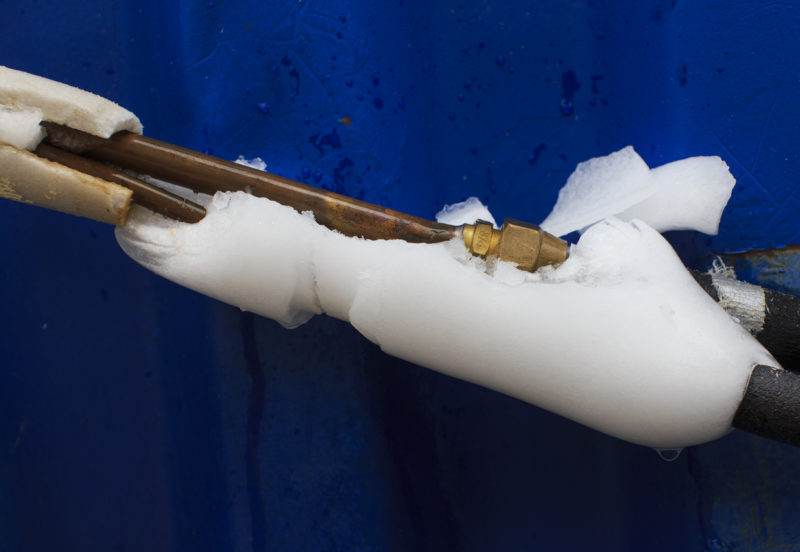Dealing With a Frozen AC Pipe - Advice for Addressing the Issue
Dealing With a Frozen AC Pipe - Advice for Addressing the Issue
Blog Article
This post in the next paragraphs about What Do I Do If My AC Pipe Is Frozen is particularly informative. Check it out for yourself and decide what you think of it.

Introduction
Uncovering that your AC pipeline is iced up can be concerning, specifically throughout hot summertime when you count on your air conditioning unit the most. Recognizing what to do in such a circumstance is crucial to stop more damage to your cooling system and guarantee your comfort inside.
Comprehending the Causes
Numerous elements can add to the freezing of an a/c pipeline. Understanding these causes can assist you resolve the issue efficiently.
Absence of Airflow
One common reason for a frozen a/c pipeline is inadequate air movement. When the air flow over the evaporator coil is restricted, it can trigger the coil to go down below freezing temperature level, leading to ice formation on the pipe.
Low Refrigerant Levels
Inadequate refrigerant degrees in your air conditioning system can additionally cause an icy pipeline. Reduced cooling agent degrees can cause the stress in the system to go down, bring about the cold of moisture on the evaporator coil.
Cold Weather Conditions
In chillier climates, freezing temperatures outside can contribute to the cold of air conditioner pipelines. If your air conditioning unit is not properly shielded or if there are leaks in the ductwork, cool air can infiltrate the system, triggering the pipeline to freeze.
Dirty Air Filters
Unclean or blocked air filters can limit airflow in your air conditioning system, bring about various problems, consisting of a frozen pipe. It's vital to change or clean your air filters regularly to ensure proper air flow and protect against ice build-up.
Indicators of a Frozen Air Conditioner Pipe
Recognizing the signs of a frozen air conditioning pipe is vital for punctual activity.
Minimized Airflow
If you discover a considerable decline in airflow from your vents, it could indicate a frozen pipeline.
Ice Buildup on the Pipe
Noticeable ice build-up on the cooling agent line or the evaporator coil is a clear sign of an icy air conditioner pipeline.
Weird Sounds from the Unit
Unusual noises, such as hissing or gurgling, originating from your air conditioner device can indicate that there's ice present on the pipeline.
Immediate Actions to Take
When faced with a frozen air conditioner pipe, it's important to act quickly to avoid additional damages to your cooling system.
Turning off the air conditioning
The first step is to turn off your air conditioning unit to avoid the system from running and worsening the problem.
Checking for Blockages
Check the area around the indoor system for any blockages that might be blocking air flow, such as furnishings or curtains.
Thawing the Pipe
You can use gentle approaches like putting towels soaked in cozy water around the icy pipeline to aid thaw it slowly.
Safety nets
Taking preventive measures can help stay clear of future incidents of a frozen AC pipe.
When DIY Methods Fail
If your efforts to thaw the pipeline or address other issues are not successful, it's time to call an expert.
Significance of Hiring a Professional HVAC Technician
A qualified HVAC specialist has the competence and tools necessary to detect and fix problems with your air conditioning system safely and successfully.
Regular Maintenance Checks
Arrange regular maintenance contact an expert HVAC service technician to make sure that your AC system is running effectively.
Transforming Air Filters
Frequently change or clean your air filters to avoid air movement constraints and keep optimum efficiency.
Protecting Exposed Pipes
If your air conditioning pipes are revealed to chilly temperatures, take into consideration shielding them to prevent cold during winter months.
Looking For Professional Help
If DIY methods fall short to deal with the concern or if you're not sure regarding just how to proceed, it's best to seek support from a certified HVAC professional.
Final thought
Taking care of a frozen a/c pipeline can be a discouraging experience, yet recognizing how to react can help decrease damage and bring back convenience to your home. By recognizing the causes, acknowledging the indicators, and taking prompt action, you can effectively attend to the concern and prevent future incidents.
What to Do If Your AC Line Is Frozen
Make Sure All Supply and Return Air Vents Are Open
If you notice problems with airflow, the first thing you should do is check your supply and return vents. Supply vents distribute clean, conditioned air throughout your home. As this air becomes stale, it’s pulled into the return vent, where it’s reconditioned before being sent back out through the supply vent.
When these vents are closed, air won’t flow in the home. Before examining your AC, check the vents in every room and ensure they’re all open.
Check for a Dirty Air Filter
Another possible cause of limited airflow is a dirty air filter. Your air conditioner’s filters catch elements you don’t want to breathe in, such as dirt and dust. Over time, filters can become clogged, ultimately blocking air from flowing in and out. The lack of airflow can then cause the entire coil to freeze and will completely restrict any air from moving through it. The AC may need to be powered off for one to two days to allow the coil to thaw after replacing the filter to allow proper functioning of the unit. This debris can also accumulate on your AC’s evaporator coil, requiring a more serious repair. In general, air filters should be cleaned regularly (about every two weeks).
Assess Your Outdoor Unit
In addition to checking your AC, assessing the outdoor unit is a good idea. Also known as the condensing unit, it works with your interior unit to release heat outside. An issue with the outdoor unit can result in rising internal temperatures.
Overgrown Shrubs or Clogged Leaves
From leaves and twigs to shrubs and debris, there’s no shortage of outdoor elements that can accumulate around your condensing unit. When these elements get lodged inside the unit, they can block airflow. Fortunately, removing the blockage can solve the problem.
Sounds of a Broken Fan
Shrubs and leaves aren’t the only things that can impede your outdoor unit’s airflow. If the fan is broken, the unit won’t be able to properly get rid of heat — which means the internal temperature won’t go down. First, make sure the fan is spinning. If it is, check for the following sounds of a broken fan:
Buzzing Rattling Screeching Hissing Clicking Preventative Measures
Nobody wants to deal with a frozen AC line. In addition to causing problems with your air conditioner, they require professional repairs. On the bright side, there are preventative measures you can take to help ensure this issue doesn’t arise in the first place.
https://www.coopergreenteam.com/blog/what-to-do-if-ac-line-frozen

Do you like more info about What Do I Do If My AC Pipe Is Frozen? Leave feedback down below. We would be pleased to know your views about this piece. Hoping to see you back again later on. You should take the time to share this blog posting if you appreciated it. I praise you for your time. Visit us again soon.
Request An Estimate Report this page